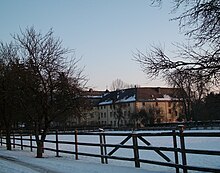Augustinian monastery in Glindfeld
The Augustinian convent in Glindfeld near Medebach was built after 1298. In 1499 it was converted into a monastery of the Kreuzherren . As such it existed until it was repealed in 1804.
history
The Archbishop of Cologne Philip I von Heinsberg confirmed in a document in 1179 the fief of a "desert court on the Ruhr" to the "custelhergensis ecclesia". However, the nuns are first mentioned in a document in 1275. In 1294, Grafschaft Monastery transferred its main courtyard in Glindfeld to Küstelberg Monastery . In return, the nuns undertook to choose their provost from Kloster Grafschaft.
On March 12, 1297, the Archbishop of Cologne, Wigbold von Holte, commissioned the abbot of the Luitbert von Rödinghausen monastery to move the Augustinian nuns from Küstelberg monastery to Glindfeld. This then took place in 1299. The funds were insufficient for the construction of the monastery church, so that donations were repeatedly called for. The church could only be completed after 1338. Started in the Romanesque style , it was redesigned into a Gothic hall church during the construction .
In 1302 the Augustinian convent "novo Quistelberg" and in 1339 "St. Maria in Glyntfelde “. The provost was elected from Kloster Grafschaft.
Despite individual donations, the monastery was considered extremely poor throughout the 14th century. The monastery received income from sheep breeding (1361/62), from various ponds and mills in the later desert areas of Ahusen near Medebach and Wernsdorf near Winterberg and another one at the mill pond.
The economic difficulties meant that important monastery goods had to be sold again and again. Towards the end of the 15th century, the monastery deteriorated more and more due to mismanagement and insufficient administration. In 1499 only two nuns lived in the monastery. At their request, Archbishop Hermann of Cologne transferred the monastery to the Order of the Cross. The two nuns and the provost received an annuity.
In 1694 the south wing of the monastery was rebuilt and in the 18th century the so-called new wing was built with the inclusion of old cellar vaults. After the abolition of the monastery, the church and the old east wing were demolished after 1804. The monastery property was sold in 1821. In the remaining buildings there was a forestry office until 1995. The owner of Gut Glindfeld built the Villa Hohe Mirke, also known as the castle, on the estate around 1900. The Medebach cultural ring organizes concerts, theater performances and art exhibitions there.
Provosts of the Glindfeld monastery
- 1299/1325 Gottfried von Padberg
- 1326/1342 Alexander von Helden
- 1347, 1353/1355 Johannes von Plettenberg
- 1351, 1356/1357 Hermann von Ostendorf
- 1361/1378 Johann Freseken
- 1381/1383 Johann von Dorfeld
- 1388 Frank von Schnellenberg
- 1400 / approx. 1450 Heidenreich von Leyssen, called Krevet
- 1464/1480 Hermann von Visbeck
- 1490/1493 Johann von Odingen
- 1496/1499 Heinrich Quatermark
literature
- Anton Führer : Historical news about Medebach and its neighboring towns. Self-published, Naumburg 1938.
- Anton Grosche: History of the Glindfeld Monastery. Self-published, Medebach 1957.
- Marie-Theres Potthoff: Glindfeld - Augustinian women, in Küstelberg until 1297. In: Karl Hengst (Hrsg.): Westfälisches Klosterbuch. Part 1: Ahlen - Mülheim. Aschendorff, Münster 1992, ISBN 3-402-06886-9 , pp. 355-359 ( Sources and research on the history of church and religion 2, publications of the Historical Commission for Westphalia 44).
- Heiko KL Schulze : Monasteries and monasteries in Westphalia - history, building history and description, a documentation. In: Géza Jászai (Ed.): Monastic Westphalia. Monasteries and monasteries 800–1800. Westfälisches Landesmuseum für Kunst und Kulturgeschichte, Münster 1982, ISBN 3-88789-054-X , p. 355 (exhibition catalog, Münster, Westfälisches Landesmuseum für Kunst und Kulturgeschichte, September 26, 1982 - November 21, 1982).
- Hermann Lohbeck: The Glindfeld monastery field - a forgotten cultural heritage, p. 164 (PDF; 7.0 MB) in Sauerland No. 4, December 1999, ISSN 0177-8110
Web links
swell
- ↑ Hermann Lohbeck: The Glindfeld Monastery Field - a forgotten cultural heritage, p. 164, ( Memento of the original from January 9, 2016 in the Internet Archive ) Info: The archive link was automatically inserted and not yet checked. Please check the original and archive link according to the instructions and then remove this notice. (PDF; 7.0 MB) in Sauerland No. 4, December 1999, ISSN 0177-8110
- ↑ On the trail of the Glindfeld monastery
- ↑ Kulturring-medebach.de - Gut Glindfeld ( Memento of the original from March 3, 2016 in the Internet Archive ) Info: The archive link has been inserted automatically and has not yet been checked. Please check the original and archive link according to the instructions and then remove this notice.
- ↑ Leader No. 89, 95, 104, 108, 117–119, 122, 125, 136, 140, 148, 151
- ↑ Leader No. 165, 166, 168, 170, 172, 174–177, 181, 192, 193, 214, 215, 240
- ↑ Guide No. 266, 284, 290
- ↑ Guide No. 274, 275, 277, 292
- ↑ Leader No. 306, 309-312, 316, 318, 320, 323, 327, 347
- ↑ Guide No. 352, 353, 358, 360
- ↑ Guide No. 366, 368
- ↑ Karl-Josef Freiherr von Ketteler, family table of Leyssen called Krevet, in: Some remarks on the sex of those von Krevet and their relatives. Not published / Ketteler family archive on Harkotten, Guide No. 398, 400, 404, 449, 517
- ↑ Guide No. 547, 551, 557-559
- ↑ Guide No. 583, 598
- ↑ Guide No. 610, 611, 613, 623, 626, 627, 630
Coordinates: 51 ° 11 ′ 59.5 ″ N , 8 ° 39 ′ 49.3 ″ E





